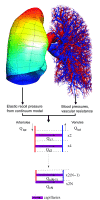Multi-scale lung modeling
- PMID: 21292842
- PMCID: PMC3098667
- DOI: 10.1152/japplphysiol.01289.2010
Multi-scale lung modeling
Abstract
Multi-scale modeling of biological systems has recently become fashionable due to the growing power of digital computers as well as to the growing realization that integrative systems behavior is as important to life as is the genome. While it is true that the behavior of a living organism must ultimately be traceable to all its components and their myriad interactions, attempting to codify this in its entirety in a model misses the insights gained from understanding how collections of system components at one level of scale conspire to produce qualitatively different behavior at higher levels. The essence of multi-scale modeling thus lies not in the inclusion of every conceivable biological detail, but rather in the judicious selection of emergent phenomena appropriate to the level of scale being modeled. These principles are exemplified in recent computational models of the lung. Airways responsiveness, for example, is an organ-level manifestation of events that begin at the molecular level within airway smooth muscle cells, yet it is not necessary to invoke all these molecular events to accurately describe the contraction dynamics of a cell, nor is it necessary to invoke all phenomena observable at the level of the cell to account for the changes in overall lung function that occur following methacholine challenge. Similarly, the regulation of pulmonary vascular tone has complex origins within the individual smooth muscle cells that line the blood vessels but, again, many of the fine details of cell behavior average out at the level of the organ to produce an effect on pulmonary vascular pressure that can be described in much simpler terms. The art of multi-scale lung modeling thus reduces not to being limitlessly inclusive, but rather to knowing what biological details to leave out.
Figures


Comment in
-
Emergent behavior in lung structure and function.J Appl Physiol (1985). 2011 Apr;110(4):1109-10. doi: 10.1152/japplphysiol.00179.2011. Epub 2011 Feb 10. J Appl Physiol (1985). 2011. PMID: 21310887 No abstract available.
Similar articles
-
Self-organized patterns of airway narrowing.J Appl Physiol (1985). 2011 May;110(5):1482-6. doi: 10.1152/japplphysiol.01163.2010. Epub 2011 Jan 20. J Appl Physiol (1985). 2011. PMID: 21252219
-
Influence of experimental conditions on parameter estimation for breathing mechanics: a sensitivity analysis approach.Med Biol Eng Comput. 1987 May;25(3):305-10. doi: 10.1007/BF02447429. Med Biol Eng Comput. 1987. PMID: 3449726 No abstract available.
-
The forces applied to the lung in health and disease.Am J Med. 1974 Sep;57(3):371-7. doi: 10.1016/0002-9343(74)90132-6. Am J Med. 1974. PMID: 4416277 No abstract available.
-
Systems-level airway models of bronchoconstriction.Wiley Interdiscip Rev Syst Biol Med. 2016 Sep;8(5):459-67. doi: 10.1002/wsbm.1349. Epub 2016 Jun 27. Wiley Interdiscip Rev Syst Biol Med. 2016. PMID: 27348217 Review.
-
Respiration: pulmonary mechanics.Annu Rev Physiol. 1973;35:169-92. doi: 10.1146/annurev.ph.35.030173.001125. Annu Rev Physiol. 1973. PMID: 4575161 Review. No abstract available.
Cited by
-
Next-generation, personalised, model-based critical care medicine: a state-of-the art review of in silico virtual patient models, methods, and cohorts, and how to validation them.Biomed Eng Online. 2018 Feb 20;17(1):24. doi: 10.1186/s12938-018-0455-y. Biomed Eng Online. 2018. PMID: 29463246 Free PMC article. Review.
-
Optimising mechanical ventilation through model-based methods and automation.Annu Rev Control. 2019;48:369-382. doi: 10.1016/j.arcontrol.2019.05.001. Epub 2019 May 7. Annu Rev Control. 2019. PMID: 36911536 Free PMC article. Review.
-
Developing a Lung Model in the Age of COVID-19: A Digital Image Correlation and Inverse Finite Element Analysis Framework.Front Bioeng Biotechnol. 2021 Oct 26;9:684778. doi: 10.3389/fbioe.2021.684778. eCollection 2021. Front Bioeng Biotechnol. 2021. PMID: 34765590 Free PMC article. Review.
-
Biomedical engineer's guide to the clinical aspects of intensive care mechanical ventilation.Biomed Eng Online. 2018 Nov 12;17(1):169. doi: 10.1186/s12938-018-0599-9. Biomed Eng Online. 2018. PMID: 30419903 Free PMC article. Review.
-
A multidisciplinary approach towards modeling of a virtual human lung.NPJ Syst Biol Appl. 2025 Apr 18;11(1):38. doi: 10.1038/s41540-025-00517-x. NPJ Syst Biol Appl. 2025. PMID: 40251169 Free PMC article. Review.
References
-
- An SS, Bai TR, Bates JH, Black JL, Brown RH, Brusasco V, Chitano P, Deng L, Dowell M, Eidelman DH, Fabry B, Fairbank NJ, Ford LE, Fredberg JJ, Gerthoffer WT, Gilbert SH, Gosens R, Gunst SJ, Halayko AJ, Ingram RH, Irvin CG, James AL, Janssen LJ, King GG, Knight DA, Lauzon AM, Lakser OJ, Ludwig MS, Lutchen KR, Maksym GN, Martin JG, Mauad T, McParland BE, Mijailovich SM, Mitchell HW, Mitchell RW, Mitzner W, Murphy TM, Pare PD, Pellegrino R, Sanderson MJ, Schellenberg RR, Seow CY, Silveira PS, Smith PG, Solway J, Stephens NL, Sterk PJ, Stewart AG, Tang DD, Tepper RS, Tran T, Wang L. Airway smooth muscle dynamics: a common pathway of airway obstruction in asthma. Eur Respir J 29: 834–860, 2007. - PMC - PubMed
-
- Bates JH. A micromechanical model of lung tissue rheology. Ann Biomed Eng 26: 679–687, 1998. - PubMed
-
- Bates JH. A recruitment model of quasi-linear power-law stress adaptation in lung tissue. Ann Biomed Eng 35: 1165–1174, 2007. - PubMed
Publication types
MeSH terms
Grants and funding
LinkOut - more resources
Full Text Sources
Other Literature Sources
Medical

